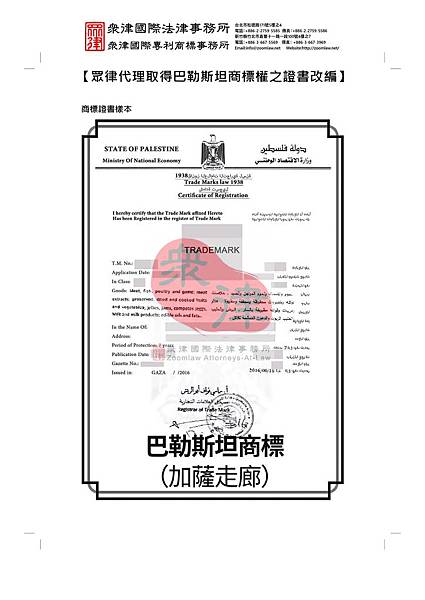
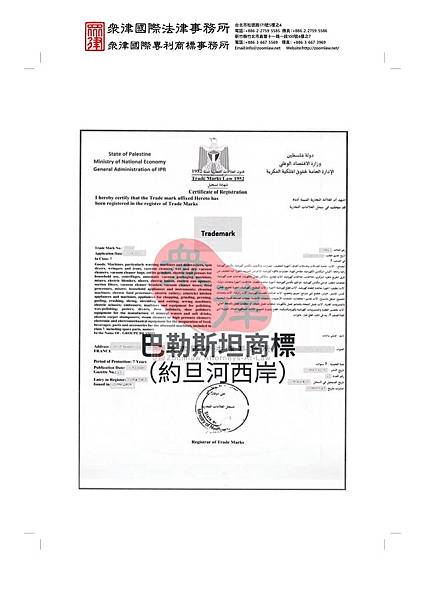
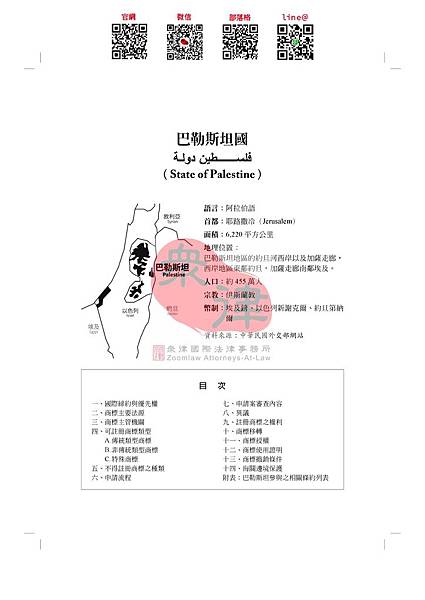
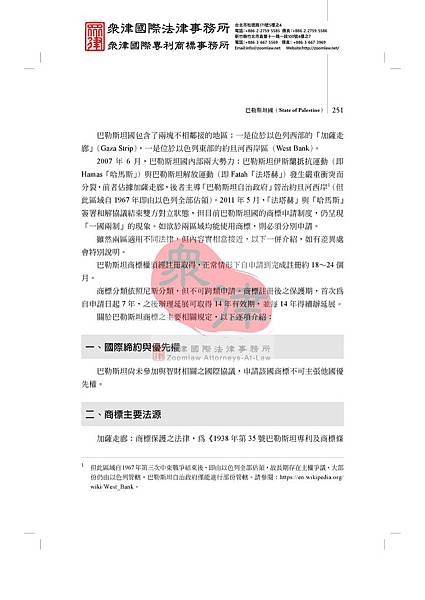
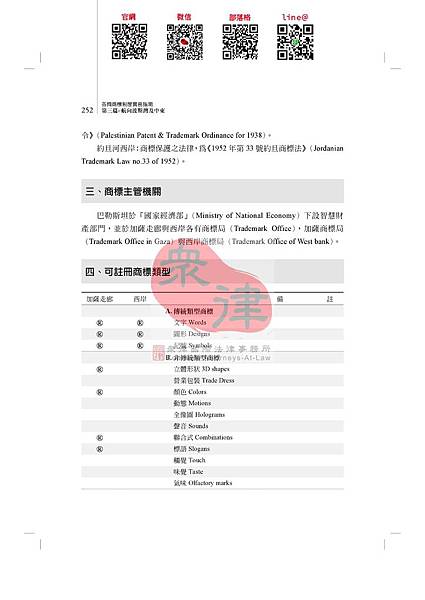

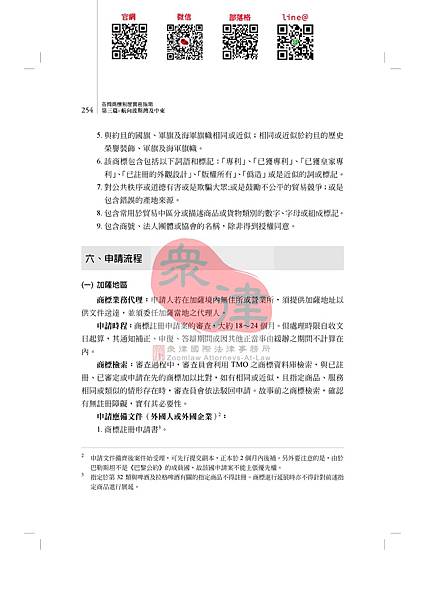
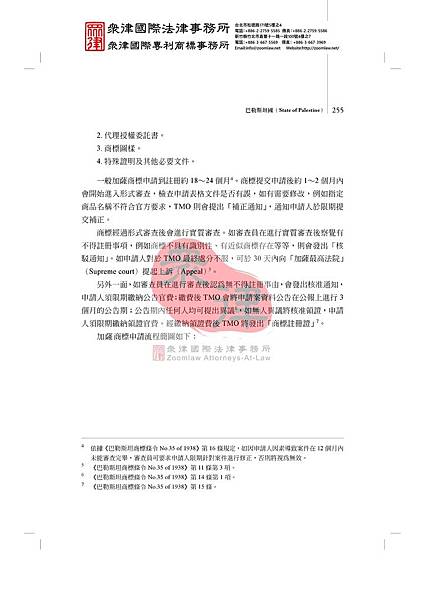
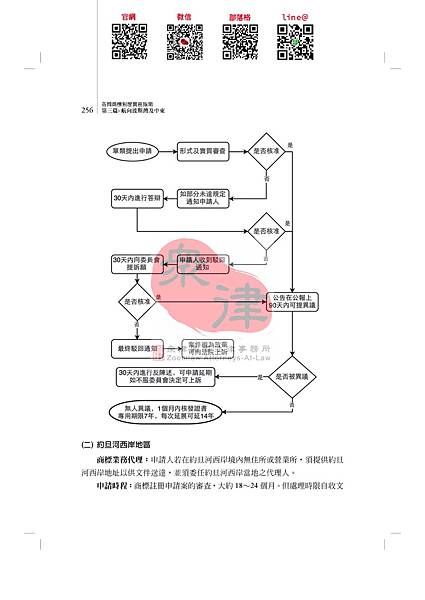


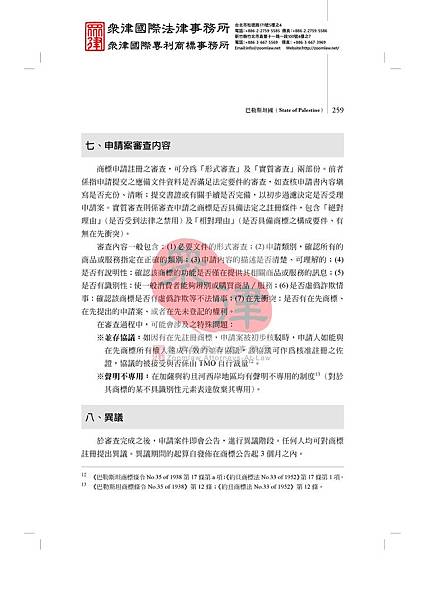
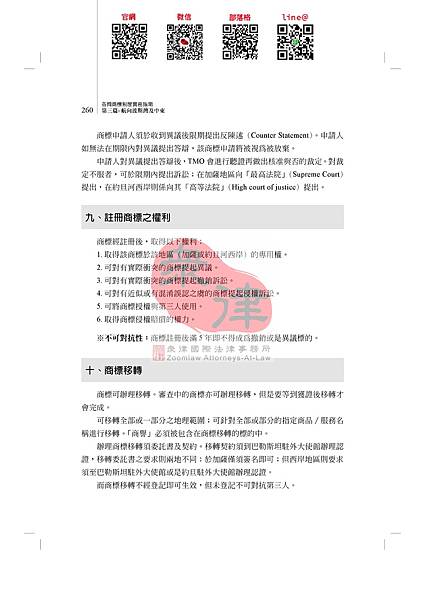



















 語言:阿爾巴尼亞語
語言:阿爾巴尼亞語
首都:地拉那(Tirana)
面積:28,748平方公里
地理位置:
北鄰塞爾維亞、蒙特內哥羅,東接馬其頓,東南與希臘接壤,西濱亞得里亞海與愛奧尼亞海。
人口:約300萬人
宗教:回教、東正教、天主教
幣制:列克(Lek)
資料來源:中華民國外交部網站
|
目 次 |
|
|
前言 一、國際締約與優先權 二、商標主要法源 三、商標主管機關 四、可註冊商標類型 A. 傳統類型商標 B. 非傳統類型商標 C. 特殊商標 五、不得註冊商標之種類 六、申請流程 |
七、申請案審查內容 八、異議 九、註冊商標之權利 十、商標移轉 十一、商標授權 十二、商標使用證明 十三、商標撤銷條件 十四、海關邊境保護 附表:阿爾巴尼亞參與之相關條約列表 |
 要取得阿爾巴尼亞商標權,須申請商標註冊。在案件進行正常的狀況(無異議提出),從申請到註冊約需9~11個月。商標註冊有效期間自申請日起算10年,之後每10年繼續延展[1]。
要取得阿爾巴尼亞商標權,須申請商標註冊。在案件進行正常的狀況(無異議提出),從申請到註冊約需9~11個月。商標註冊有效期間自申請日起算10年,之後每10年繼續延展[1]。
阿爾巴尼亞商標採用尼斯分類,可跨類申請。本地不強制要求已註冊商標加註特殊標示,但仍以加上註冊標示為宜,藉此得以公開宣示其註冊地位。
關於阿爾巴尼亞商標之主要相關規定,請看眾律商標電子書介紹:
![]() 🥇選購如下
🥇選購如下
1.各國商標制度實務指南 系列1:RCEP、TPP及台商主要申請國
http://www.books.com.tw/products/0010736164
2.各國商標制度實務指南 系列3:一帶一路(下)海上絲綢之路篇
http://www.books.com.tw/products/0010789211
![]() 歡迎來電本所
歡迎來電本所![]()
商標諮詢請於上班時間(週一至週五早上9點~晚上6點,12:00-13:00午休時間)來電,謝謝您
![]() 諮詢專線: 台北(02)2759-5585 | 新竹(03)667-5569
諮詢專線: 台北(02)2759-5585 | 新竹(03)667-5569
台北:台北市信義區松德路171號5樓之4
(近捷運象山站3號出口,步行10分鐘)
新竹:新竹縣竹北市嘉豐十一路一段100號4樓之7
(近高鐵新竹站2號出口前富翼大樓,步行10分鐘)
或來信 E-mail: info@zoomlaw.net
所長法學博士范國華律師敬啟
[1] 延展日前6個月開始受理延展申請,逾期有12個月的寬限期,並需繳納滯納金。在逾期7~12月間辦理延展,必須提報逾期辦理的正當理由,且商標局有權決定是否接受該說明並決定是否接受申請延展。
https://www.tipo.gov.tw/lp.asp?CtNode=7047&CtUnit=3491&BaseDSD=7&mp=1
 語言:官方語言為阿拉伯語;通行英語。
語言:官方語言為阿拉伯語;通行英語。
首都:多哈(Doha)
面積:11,586平方公里
地理位置:
東、西、北臨阿拉伯(波斯)灣,南與沙烏地接壤之半島國家。
人口:219萬人
宗教:伊斯蘭教
幣制:Qatari Riyal (QAR)
資料來源:中華民國外交部網站
|
目 次 |
|
|
前言 一、國際締約與優先權 二、商標主要法源 三、商標主管機關 四、可註冊商標類型 A. 傳統類型商標 B. 非傳統類型商標 C. 特殊商標 五、不得註冊商標之種類 六、申請流程 |
七、申請案審查內容 八、異議 九、註冊商標之權利 十、商標移轉 十一、商標授權 十二、商標使用證明 十三、商標撤銷條件 十四、海關邊境保護 附表:卡達參與之相關條約列表 |
 卡達曾為英國之保護國,至1971年正式獨立。卡達半島為波斯灣所環繞,早年以捕魚及沿海珍珠養殖業為主,1940年代後發現擁有豐富的石油和天然氣資源,天然氣總儲量全球排名第三(僅次為俄羅斯及伊朗),石油和天然氣讓卡達成為世界上最富裕的國家,人均GDP為世界首位。
卡達曾為英國之保護國,至1971年正式獨立。卡達半島為波斯灣所環繞,早年以捕魚及沿海珍珠養殖業為主,1940年代後發現擁有豐富的石油和天然氣資源,天然氣總儲量全球排名第三(僅次為俄羅斯及伊朗),石油和天然氣讓卡達成為世界上最富裕的國家,人均GDP為世界首位。
卡達商標註冊之保護期限為自申請日起算10年,期滿得以相同之期限不限次數續展。卡達商標採用尼斯分類[1]。一案不可跨類申請,須一類一案。
卡達不強制要求已註冊商標須放上註冊標誌,實務上仍以加上註冊標示為宜,藉此得以公開提醒第三人其商標註冊地位。如要使用註冊標誌,可用TM(未註冊)及®(已註冊)。
關於卡達商標之主要相關規定,請看眾律商標電子書介紹:
![]() 🥇選購如下
🥇選購如下
1.各國商標制度實務指南 系列1:RCEP、TPP及台商主要申請國
http://www.books.com.tw/products/0010736164
2.各國商標制度實務指南 系列3:一帶一路(下)海上絲綢之路篇
http://www.books.com.tw/products/0010789211
![]() 歡迎來電本所
歡迎來電本所![]()
商標諮詢請於上班時間(週一至週五早上9點~晚上6點,12:00-13:00午休時間)來電,謝謝您
![]() 諮詢專線: 台北(02)2759-5585 | 新竹(03)667-5569
諮詢專線: 台北(02)2759-5585 | 新竹(03)667-5569
台北:台北市信義區松德路171號5樓之4
(近捷運象山站3號出口,步行10分鐘)
新竹:新竹縣竹北市嘉豐十一路一段100號4樓之7
(近高鐵新竹站2號出口前富翼大樓,步行10分鐘)
或來信 E-mail: info@zoomlaw.net
所長法學博士范國華律師敬啟
[1] 但第29類與「豬肉」有關之商品、第32類與「酒精」有關之商品、以及第33類商品不得申請。
https://www.tipo.gov.tw/lp.asp?CtNode=7047&CtUnit=3491&BaseDSD=7&mp=1
 語言: Maldivian Dhivehi,政府官員多使用英文
語言: Maldivian Dhivehi,政府官員多使用英文
首都: 馬列(Malé)
面積: 298平方公里(世界排名第206名)
地理位置:
位於印度洋赤道附近,印度南方600公里,斯里蘭卡西南方700公里,由1,192個珊瑚礁小島組成,僅200個有人居住,各島平均不超過海拔1.8米。
人口: 36.9萬人
宗教: 遜尼回教(Sunni Muslim)
幣制: Rufiyaa
資料來源:中華民國外交部網站
 馬爾地夫「經濟發展部」(Ministry of Economic Development, MED)於2007年組建了「智慧財產組」(Intellectual Property Unit)執行相關法律之草擬及智財觀念普及工作。2011年通過「版權與相關權利法」(Copyright and Related Rights Law),係該國唯一保護智慧財產權之法律,文學藝術作品版權開始受到保護,但商標法及地理標誌法仍處於研修階段[1]。
馬爾地夫「經濟發展部」(Ministry of Economic Development, MED)於2007年組建了「智慧財產組」(Intellectual Property Unit)執行相關法律之草擬及智財觀念普及工作。2011年通過「版權與相關權利法」(Copyright and Related Rights Law),係該國唯一保護智慧財產權之法律,文學藝術作品版權開始受到保護,但商標法及地理標誌法仍處於研修階段[1]。
為滿足商標權主張之需要,依據該國普通法(Common law)的概念,目前實務做法就是在馬爾地夫當地主要報紙上刊登警示通知(Cautionary Notice),公開宣告商標之所有權歸屬,以避免商標在該國遭到侵害。公告的有效期限3年,僅需要提交商標資訊及申請人資訊及可,不需要委任狀。從提交申請到公告須3~4周作業時間。
有關商標保護效期、延展等實質與程序規定,仍屬於空白;不過依據實務經驗,商標可以以每3年重新刊登警示通知的方式進保護。
關於馬爾地夫商標之主要相關規定,請看眾律商標電子書介紹:
![]() 🥇選購如下
🥇選購如下
1.各國商標制度實務指南 系列1:RCEP、TPP及台商主要申請國
http://www.books.com.tw/products/0010736164
2.各國商標制度實務指南 系列3:一帶一路(下)海上絲綢之路篇
http://www.books.com.tw/products/0010789211
![]() 歡迎來電本所
歡迎來電本所![]()
商標諮詢請於上班時間(週一至週五早上9點~晚上6點,12:00-13:00午休時間)來電,謝謝您
![]() 諮詢專線: 台北(02)2759-5585 | 新竹(03)667-5569
諮詢專線: 台北(02)2759-5585 | 新竹(03)667-5569
台北:台北市信義區松德路171號5樓之4
(近捷運象山站3號出口,步行10分鐘)
新竹:新竹縣竹北市嘉豐十一路一段100號4樓之7
(近高鐵新竹站2號出口前富翼大樓,步行10分鐘)
或來信 E-mail: info@zoomlaw.net
所長法學博士范國華律師敬啟
[1] 馬爾地夫「經濟發展部」網站http://www.trade.gov.mv/page/ipr。
 語言: 僧伽羅語(Sinhala)、泰米爾語(Tamil)、英語
語言: 僧伽羅語(Sinhala)、泰米爾語(Tamil)、英語
首都: 斯里賈亞瓦德納普拉科特(Sri Jayewardenepura Kotte),簡稱科特。
面積: 65,610平方公里
地理位置:
位於南亞之印度半島東南端,為印度洋島國,東北為孟加拉灣(Bay of Bangal),西北以曼納灣(Gulf of Mannar)及保克海峽(Palk Strait)與印度相望。
人口: 約2,148萬人(2012年3月)
宗教: 佛教、回教、印度教、基督教
幣制: 斯里蘭卡盧比(LKR)
資料來源:中華民國外交部網站
|
目 次 |
||
|
前言 一、國際締約與優先權 二、商標主要法源 三、商標主管機關 四、可註冊商標類型 A. 傳統類型商標 B. 非傳統類型商標 C. 特殊商標 |
五、不得註冊商標之種類 六、申請流程 七、申請案審查內容 八、異議 九、註冊商標之權利 十、商標移轉 十一、商標授權 十二、商標使用證明 |
十三、商標撤銷條件 十四、海關邊境保護 附表: 斯里蘭卡參與之相關條約列表 |
 斯里蘭卡古稱「錫蘭」,自1815年起成為大英帝國殖民地,正式名稱為「Ceylon」(源於葡萄牙語Ceilão),漢譯「錫蘭」。1948年錫蘭獨立成為大英國協的「錫蘭自治領」,1972年錫蘭廢除君主制,改稱「斯里蘭卡共和國」。
斯里蘭卡古稱「錫蘭」,自1815年起成為大英帝國殖民地,正式名稱為「Ceylon」(源於葡萄牙語Ceilão),漢譯「錫蘭」。1948年錫蘭獨立成為大英國協的「錫蘭自治領」,1972年錫蘭廢除君主制,改稱「斯里蘭卡共和國」。
自1830年代,英國將印度南部的泰米爾人(Indian Tamil)大批遷至斯里蘭卡,扶持其占據主導地位,致使與當地主要民族僧伽羅人(Sinhalese)糾結衝突。斯里蘭卡獨立後,泰米爾人於1976年成立了「泰米爾-伊拉姆猛虎解放組織」(Liberation Tigers of Tamil Eelam,簡稱Tamil Tigers或LTTE),使斯里蘭卡陷入1983~2009年長達26年內戰中[1],此後政治社會漸趨穩定,開始進入和平發展期,經濟穩健發展。
由於歷史原因,斯里蘭卡的眾多機構以及產品都仍以「錫蘭」為名。2011年斯里蘭卡政府宣布將在所有政府可以控制的機構名稱中將「錫蘭」改為「斯里蘭卡」(紅茶例外)。
斯里蘭卡商標註冊非強制性,未註冊商標仍可獲得普通法關於仿冒行為(passing off)之保護,但相較於註冊商標,仍以後者之保障較容易及全面。
斯里蘭卡商標採尼斯分類,不可跨類申請,須一案一類。商標保護期自申請日起算10年,期滿之後可繼續延展,每次延展10年。
商標的註冊指示標誌,可用TM(已申請尚未完成註冊)及®(已註冊)。未註冊而使用®標誌係屬違法行為,TM則不受限制。
關於斯里蘭卡商標之主要相關規定,請看眾律商標電子書介紹:
![]() 🥇選購如下
🥇選購如下
1.各國商標制度實務指南 系列1:RCEP、TPP及台商主要申請國
http://www.books.com.tw/products/0010736164
2.各國商標制度實務指南 系列3:一帶一路(下)海上絲綢之路篇
http://www.books.com.tw/products/0010789211
![]() 歡迎來電本所
歡迎來電本所![]()
商標諮詢請於上班時間(週一至週五早上9點~晚上6點,12:00-13:00午休時間)來電,謝謝您
![]() 諮詢專線: 台北(02)2759-5585 | 新竹(03)667-5569
諮詢專線: 台北(02)2759-5585 | 新竹(03)667-5569
台北:台北市信義區松德路171號5樓之4
(近捷運象山站3號出口,步行10分鐘)
新竹:新竹縣竹北市嘉豐十一路一段100號4樓之7
(近高鐵新竹站2號出口前富翼大樓,步行10分鐘)
或來信 E-mail: info@zoomlaw.net
所長法學博士范國華律師敬啟
[1] https://en.wikipedia.org/wiki/Liberation_Tigers_of_Tamil_Eelam.

語言: 英語及孟加拉語
首都: 達卡(Dhaka)
面積: 14萬7,570平方公里
地理位置:
位於印度東北方,東南與緬甸為鄰,南鄰孟加拉灣,地勢低平。
人口: 1億6,291萬人(2016)
宗教: 回教、印度教
幣制: 塔卡(Taka)
資料來源:中華民國外交部網站
|
目 次 |
|
|
前言 一、 國際締約與優先權 二、 商標主要法源 三、 商標主管機關 四、 可註冊商標類型 A. 傳統類型商標 B. 非傳統類型商標 C. 特殊商標 五、 不得註冊商標之種類 六、 申請流程 |
七、申請案審查內容 八、 異議 九、 註冊商標之權利 十、商標移轉 十一、商標授權 十二、商標使用證明 十三、商標撤銷條件 十四、海關邊境保護 附表:孟加拉參與之相關條約列表 |

孟加拉目前仍屬於低度開發國家,但該國在2010~2015年間,GDP平均成長率均在6%以上,經濟成長率可望於未來幾年內達平均7%,可望在2021年能從低度開發國家中除名,躋身開發中國家之列。
在孟加拉商標註冊並非強制性,未註冊商標仍可依普通法向侵權者起訴,但未註冊商標之權利保障僅限於該商標被使用之有限地理範圍,無法擴及全國。孟國智慧財產權侵權情形頗多,法律保護執法情形有待加強。
孟加拉商標採尼斯分類(含商品1~34類及服務35~45類),不可跨類申請,只可一申請案一個商品∕服務類別。商標保護期自申請日起算7年,期滿之後可不限次數繼續延展,每次得延展10年。
商標的註冊指示標誌,可用TM(已申請尚未完成註冊)及®(已註冊)。未註冊而使用®標誌係屬違法行為,TM則不受限制。
關於孟加拉商標之主要相關規定,請看眾律商標電子書介紹:
![]() 🥇選購如下
🥇選購如下
1.各國商標制度實務指南 系列1:RCEP、TPP及台商主要申請國
http://www.books.com.tw/products/0010736164
2.各國商標制度實務指南 系列3:一帶一路(下)海上絲綢之路篇
http://www.books.com.tw/products/0010789211
![]() 歡迎來電本所
歡迎來電本所![]()
商標諮詢請於上班時間(週一至週五早上9點~晚上6點,12:00-13:00午休時間)來電,謝謝您
![]() 諮詢專線: 台北(02)2759-5585 | 新竹(03)667-5569
諮詢專線: 台北(02)2759-5585 | 新竹(03)667-5569
台北:台北市信義區松德路171號5樓之4
(近捷運象山站3號出口,步行10分鐘)
新竹:新竹縣竹北市嘉豐十一路一段100號4樓之7
(近高鐵新竹站2號出口前富翼大樓,步行10分鐘)
或來信 E-mail: info@zoomlaw.net
所長法學博士范國華律師敬啟
我國發明專利侵害鑑定之方法(下)專利工程師 / 陳詠容
Ways to examine invention patent infringements in Taiwan (3)
Patent Engineer Yung-Zhong Chen
專利範圍雖無歷史禁反言之適用,惟如被控侵權對象與先前技術相同,或依先前技術所能輕易完成者,為避免專利權人藉由均等論擴張後之範圍,涵蓋與先前技術相同或依先前技術所能輕易完成之部分,造成公眾利益受有損害。被控侵權對象經判斷與某一先前技術相同,或為一先前技術與專利申請時之所屬技術領域中的通常知識之簡單組合,或為二以上先前技術之簡單組合,則得依先前技術阻卻主張不適用均等論。Despite there is no doctrine of prosecution history estoppel, the accused party must not ensnare the prior art, nor to have its prior art to be easily accomplished. This is to avoid the scope of claims expansion beyond their literal language to the true scope of inventor’s contribution and to damage its public interests. In circumstances where an accused device performs the same function recited in the element, and the accused device embodies the corresponding structure, material, or acts described by the specification or an equivalent thereof, if any of the above elements apply, then a claim cannot be broadened. The range of equivalents permitted under the doctrine of equivalents must not ensnare its prior art. The fundamental purpose of all evaluations must prevent the patentee from obtaining, under the doctrine of equivalents, coverage which the patentee could not have obtained by literal claims.
而發明專利權範圍,以申請專利範圍為準;於解釋申請專利範圍時,得審酌說明書及圖式,此乃《專利法》第58條第4項所明文。說明書或圖式中有揭露,但並未記載於專利之請求項的技術手段,非屬專利法所賦予專利權的保護範圍內,專利權人不得以均等論重為主張或復奪(recapture)其原可於專利請求項中申請,卻不申請之技術手段。貢獻原則的意旨便在於,如說明書或圖式中有揭露但未於請求項主張之技術,應被視為貢獻給社會大眾,專利權人不得藉由均等論而重為主張其原可申請卻不申請之技術手段。Patent Law Article 58, Paragraph 4 expressly indicates that the scope of patent right shall be determined based on the claim(s) set forth in the specification of the invention. The descriptions and drawings of the invention may be used as reference when interpreting the scope of claims in the patent application. In terms of the scope of contents which were disclosed in the original specification or drawing while filing the patent application, for claims that are not written in its description, won’t be covered by Patent Law. Such claim cannot be broadened so far as to read on the prior art and a patentee cannot recapture what was given up during the prosecution of the patent. The fundamental purpose is to prevent the patentee to cover its claim which could not have obtained from the Patent and Trademark Office by literal claim to preserve the best interest of public to prevent patentee to expand or alter the scope of patent claims.
誠如國內學術文章已指出,美國最高法院在肯認均等論保護專利範圍的,認為此種不確定性乃是為了保護創新所必要付出的代價的原則之下,惟趨勢上,仍呈現出一股限縮均等論適用之浪潮。主要係均等論的適用會使得申請範圍具有不確定性,難以清楚劃定專利權範圍的界限,容易導致競爭者產生難以預期的訟爭,或者後進者在投入產品生產製照後,對於侵權與否,存有高度的不確定性,造成司法資源有浪費之疑慮。此種趨勢,亦促使我國於「2015年專利侵害要點草案」中,擬納入申請歷史禁反言、先前技術阻卻及貢獻原則等限制均等論之相關規範。According to Taiwan’s scholarly articles indicates that, the US Supreme Court adopted the doctrine of equivalents analysis, despite its uncertainties, it is necessary to preserve its invention by all means. However there appears to have a trend of narrowing the literal scope of the patent claim. The purpose of such is to avoid uncertainties, circumstances where it’s difficult to draw clear lines for the scope of patent claims that would mislead its competitors for unpredictable litigations. To prevent waste of its judicial resources, it is necessary to prevent uncertainties for the later not knowing whether there are any infringements for its manufactured products. Due to this, the “key points on invention patent infringement draft 2015” inherited the prosecution history estoppel and the prior art principles into the rules of doctrine of equivalents.
參考資料:References
專利侵害鑑定要點,經濟部智慧財產局,2004年。Intellectual Property Office (2004) Key points on invention patent infringement.
專利侵害鑑定要點草案, 經濟部智慧財產局,2015年。Intellectual Property Office (2015) Key points on invention patent infringement draft.
專利法。Patent Laws
劉尚志、張添榜、陳薈潁,專利均等侵害判斷之判決分析:由美國專利案例觀照臺灣最高法院判決,台灣法學雜誌第219期,2013年,第112-143頁。Shang-Zhi Liu., Tian-Bang Zhang., Hui-Ying Chen. (2013) Case analysis on patent infringement: using US Supreme Court’s patent case as reflection on Taiwan Supreme Court’s ruling. Taiwan Law Journal 219 edition, page 112-143.
我國發明專利侵害鑑定之方法(中)專利工程師 / 陳詠容
Ways to examine invention patent infringements in Taiwan (2)
Patent Engineer Yung-Zhong Chen
相對於均等論,專利範圍雖符合文義讀取,惟倘其技術手段與被控侵權對象所使用之技術原理,係以實質不同的手段,達到相同或類似的功能或結果,即使被控對象落入專利之文義範圍內,應判斷其適用逆均等論,不構成侵權。然而,逆均等論所欲避免的「文義相同但實質不同」的目的,近年來,在美國專利實務上,大多在鑑定流程的第一步,解釋申請專利範圍時便已解決,逆均等論僅是在判決中附帶的論述,似無直接適用逆均等論而認定不侵權的案例。配合實務現況,我國「2015年要點草案」擬刪除逆均等論之相關規範。
According to the doctrine of equivalents theory, despite the scope of clams is in line with the context, to determine whether such difference is “insubstantial” or not, it is important to figure out the difference between the feature in the accused device and the limitation literally recited in the patent claim. The patent claim may be found to be “insubstantial” only if its technical means and the accused parties perform substantially the different function in a substantial different way with substantial different results. Nevertheless, the doctrine of equivalents analysis is applied to individual claim limitations, not to the invention as a whole. In the United States, there only needs one kind of identity test to come to its conclusion for which the doctrine of equivalent is only considered as claimed of invention which described its purpose that does not directly allow a court to hold a party liable for patent infringement. In Taiwan, the “Key point draft 2015” deleted everything against the doctrine of equivalents theory.
有鑑於文字之敘述有其侷限性,無法合理期待專利權人於申請專利時能將所有無法預見但實質相同的技術特徵寫入請求項中,因此,專利權範圍不應僅侷限於文義範圍,而應包含均等範圍,此乃均等論之意旨。然而,均論一方面藉由擴張專利範圍的方式,保全專利權人之權益,另一方面,卻造成公眾無法由專利公告的字面得知專利權的範圍,使得專利侵權的判斷充滿不確定性,甚至提高訴訟與社會成本。在這樣的情況之下,均等論實有必要被適當的限縮。相較於2004年的「專利侵害鑑定要點」,我國智財局於「2015年專利侵害鑑定要點草案」納入均等論之限制事項。倘專利符合申請歷史禁反言、先前技術阻卻及貢獻原則,則被控侵權對象應視為未落入專利範圍內。
Due to the fact that when interpreting patent claims, there is strict literalism, which cannot reasonably expect patentee to write down all the claims which cannot foreseen when lodging its patent application. Therefore the scope of claim should not be read literally for which a patent literally “reads on” an accused infringer’s device or process rather than looking at its intention. Nevertheless, the expansion of claim coverage is to protect its patentees’ right, would cause the general public not knowing the actual scope of its patent claims in result of uncertainties. Whether there are any patent infringements or not would give rise to its litigation and social costs. Therefore, the doctrines of equivalents would need to narrow the literal scope of the patent claim. By comparing the “key points on invention patent infringement in 2004”, the” key points on invention patent infringement draft 2015”, the expansion of claim coverage permitted the doctrine of equivalents, however the patentee is limited by the doctrine of prosecution history estoppel and the prior art.
呈上,專利權人於專利申請過程為符合專利申請要件或為維護專利,而所為之修正、更正或申復,導致最後限縮專利權範圍,則專利權人便無法依據均等論主張其於申請專利時無法預見但實質相同的技術特徵。換而言之,該修正、更正或申復將導致放棄的部分,專利權人不得再藉由均等論而重為主張其所放棄之申請標的,此即所謂的歷史禁反言。From the above analysis, for the patentee to fulfill its patent application requirement so as to maintain its patent, it is necessary to amend, correct and response in result of narrowing the scope of claims, patentee cannot claim for something which cannot foresee base on the doctrine of equivalents theory. In other words, patentee who has filed a patent application and then to amend, correct and response its claim by narrowing its amendments to accommodate the patent law, would be precluded from invoking the doctrine of equivalents to broaden the scope of their claims to cover subject matter ceded by the amendments.
參考資料:References
專利侵害鑑定要點,經濟部智慧財產局,2004年。Intellectual Property Office (2004) Key points on invention patent infringement.
專利侵害鑑定要點草案, 經濟部智慧財產局,2015年。Intellectual Property Office (2015) Key points on invention patent infringement draft.
專利法。Patent Laws
劉尚志、張添榜、陳薈潁,專利均等侵害判斷之判決分析:由美國專利案例觀照臺灣最高法院判決,台灣法學雜誌第219期,2013年,第112-143頁。Shang-Zhi Liu., Tian-Bang Zhang., Hui-Ying Chen. (2013) Case analysis on patent infringement: using US Supreme Court’s patent case as reflection on Taiwan Supreme Court’s ruling. Taiwan Law Journal 219 edition, page 112-143.
我國發明專利侵害鑑定之方法(上)專利工程師 / 陳詠容
Ways to examine invention patent infringements in Taiwan (1)
Patent Engineer Yung-Zhong Chen
為了保護發明人的智慧財產權,我國專利法授予專利權人於一定的期間內,享有法律賦予之專利權,排除他人未經其同意而實施其專利。而當他人未經專利權人同意而製造、販賣、為販賣之要約、使用或為上述目的而進口其專利物品時,專利權人得依《專利法》及《民法》請求損害賠償。倘專利侵權案件有爭議,雙方當事人得尋求法律途徑解決。法院在受理發明專利訴訟案件時,依據《專利法》第103條第2項及第3項規定,得囑託司法院指定之侵害專利鑑定專業機構為鑑定。經濟部智慧財產局(以下簡稱「智財局」)為有助於侵害專利鑑定機構提昇作業之正確性,遂提出「專利侵害鑑定要點」供法官於送鑑定時參考。
In order to protect inventor’s intellectual property right, Taiwan’s patent law authorities may grant its patentee, within a considerable period of time, some legal patent rights. Unless otherwise provided in this Act, the patentee of a patented article shall have the exclusive right to preclude others from manufacturing, making an offer to sale, selling, using or importing for above purposes the patented article without his/her prior consent. Patentee can request for damages in pursuant to the “Patent Law” and “Civil Law”. If disputes arises in terms of infringement on an invention patent, both parties can resolve its conflict through litigation, Pursuant to Patent Law Article 103, Paragraph 2(3) in regards to litigation involving an invention patent, the Judicial Yuan may appoint specific professional institution(s) to perform the expert verification work as required in patent infringement case. In order to help to increase the accuracy for specific professional institution(s) to perform the expert verification work as required in patent infringement case(s), the Ministry of Economic Affairs Intellectual Property Office (“Intellectual Property Office”), may list out all the relevant evidences of invention patent infringements before court.
智財局於2015年草擬的「專利侵害鑑定要點草案」(以下簡稱「2015年要點草案」)中指出,在判斷專利是否有被侵害時,應先解釋專利範圍之文字意義,以合理界定專利權範圍。後比對經文字解釋後之專利技術特徵,及被控侵權對象之技術內容的差別。文字意義解釋的用意在於確認專利是否完全對應表現在被控侵權對象中(文義讀取)。一般常見被控侵權物雖未落入文義讀取的範圍內,惟其僅就其申請專利範圍之技術特徵稍作非實質之改變或替換,基於保障專利權人利益的立場,專利權範圍得擴大至,與專利範圍之技術特徵均等的範圍,而非僅侷限於專利之文義範圍(均等論)。According to the “key points on invention patent infringement draft” (“key point draft 2015”) indicates that in order to examine there is any invention patent infringements, shall understand its literal meaning written in its specifications so as to know what is covered in its claims and the drawings of the application. After having its literal interpretation done on its technical patent and infringement parties’ technical contents of an invention, it is to confirm whether such infringements are truly reflected to the corresponding object (literally). Despite the general infringement has not been written in its specification, if you make some amendments to its claims and the drawings of the application, would protect patentee’s best interest by expanding its clams of specification. By pursuing the doctrine of equivalents would allow a court to hold a party liable for patent infringement despite such infringement does not fall within the literal scope of a patent claim, but can nevertheless be equivalent to the claimed invention (doctrine of equivalents).
我國有部分法院見解在判斷被控侵權物是否落入均等範圍時,已採取美國的三步測試法,比較兩者之間是否以實質相同的手段,達成實質相同的功能,進一步判斷是否產生實質相同的結果。值得注意的是,均等論如被過度廣泛應用,勢必將會與智財局公告的專利保護範圍產生衝突,而法院判決並沒有權利擴大專利局核准的專利範圍。因此,均等論與文義讀取皆應建立在全要件原則的基礎上,專利範圍請求項經智財局公告的專利範圍,都被視為決定專利範圍的重要限制,亦即,申請專利請求項中的技術特徵,均用於比對被控侵權對象。 In order to determine whether such infringement falls into its doctrine of equivalents category, Taiwan adapted United States’ “triple identity” test on whether the accused device performs substantially the same function, in substantially the same way and to yield substantially the same result. However, if the “doctrine of equivalents” is being used widely, conflict may arise with the scope of patent protection made by the Intellectual Property Office. The court may not have the power to expand the scope of the claims and the drawings of the application. Therefore, the “doctrine of equivalents” and its literature should be built on the full requirements. Where the contents of an invention claimed in a patent application are published, would be treated as major decision to restrict the scope of patent claiming. Therefore, the scope of claims shall indicate distinctly on its technical features so as to identify the alleged infringement parties.
參考資料:References
專利侵害鑑定要點,經濟部智慧財產局,2004年。Intellectual Property Office (2004) Key points on invention patent infringement.
專利侵害鑑定要點草案, 經濟部智慧財產局,2015年。Intellectual Property Office (2015) Key points on invention patent infringement draft.
專利法。Patent Laws
劉尚志、張添榜、陳薈潁,專利均等侵害判斷之判決分析:由美國專利案例觀照臺灣最高法院判決,台灣法學雜誌第219期,2013年,第112-143頁。Shang-Zhi Liu., Tian-Bang Zhang., Hui-Ying Chen. (2013) Case analysis on patent infringement: using US Supreme Court’s patent case as reflection on Taiwan Supreme Court’s ruling. Taiwan Law Journal 219 edition, page 112-143.
專利進步性之判斷(一)—美國判例於進步性之原則— 專利工程師 / 陳詠容
Discretion of whether such patent has useful improvement to the existing solution (1) – improvement to the existing solution principles in Taiwan - Patent Engineer Yung-Zhong Chen
一、前言 Preamble
新穎性、進步性與產業可利用性為取得專利權之三大要件,發明欲取得專利權需同時兼具該三要素。然而綜觀專利行政爭訟與民事訴訟之案例,不難發現近期與進步性相關的爭議佔了絕大部份之比例。本文分作四篇,前兩篇先帶讀者了解美國判例對於進步性所建立出之判斷準則,接著檢視該準則與我國現行專利法與專利審查基準對於進步性判斷基準之異同,最後探討我國實務判決之判定標準。
The issue of novelty, improvement to the existing solution, and industrial usefulness are the three main requirements to gain its patent right. By looking at the patent administrative litigation and civil litigation case studies, it is not hard to find that there are more topics focuses on its controversial issues of improvement to the existing solution principles. This article would be divided into four parts; the first two articles would lead our reader to understand how the America’s case study can influence on its discretion of whether its patent has useful improvement to the existing solution, followed by examining its judicial reasoning by comparing our current patent examination procedure. Lastly, we will discuss Taiwan’s case judgements and its criteria standards.
二、美國判例於進步性之原則
America’s case implications on its improvement to the existing solution principles
美國對於進步性之判斷,早已豎立了TSM檢測法,即教示(Teaching)、建議(Suggestion)及動機(Motivation)。而1966年美國最高法院於Graham v. John Deere Co.[1]案(以下簡稱「Graham案」)提出進步性分析原則[2]:(1) 確定先前技術之範圍與內容;(2) 確定先前技術與有爭議之專利範圍請求項間之區別;(3) 確定相關領域一般技術之水準。如經此三步驟判斷出爭議專利範圍請求項係其所屬領域中具通常知識者可輕易完成者,則該發明則為顯而易見,惟仍須同時考量爭議之專利範圍是否有商業上成功、解決長期未解決之問題、或他人皆無法成功發明等次要衡量因素。然而,TSM檢測法在美國實務運作卻產生引證資料只限於明示,且忽略所屬技術領域中具有通常知識者之角色等問題[3]。
In terms of America’s discretion of whether such patent has useful improvement to the existing solution, there is implications on the TSM test and concepts including teaching, suggestion and motivation. In the case of Graham v John Deere Co (1996), (“Graham” case) list out all the elements when determining whether its application has improvement to the existing solution on principles. This includes: (1) confirm the claims and the drawings of the application; (2) confirm its prior art and the disputed claims and the drawings of the current application; (3) confirm relevant skills in the relevant field. Once we determine the three steps in terms of its patent dispute range that an ordinary person can be easily accomplished, such patent would be treated as ‘obvious to try’ and its case would be treated as invalid. However examiner should also need to balance and to take other factors into account such as how wide is its patent claiming and whether there is any business success, long term problem solving solutions or others inventions that cannot be easily accomplished by an ordinary person. However by looking at the implications of the TSM test, it only included ‘obvious to try’ principle in practice but neglected to look at its technology field problems for which an ordinary person would have.
2007 年美國最高法院於 KSR v. Teleflex 案[4]除了重申Graham判決提出的分析方法應為廣泛、彈性,更指出TSM檢測法之運用不宜僵化[5],認為[6] (1) 引證案不應侷限於所欲解決的問題相同;(2) 先前技術應涵蓋所有技術領域; (3) 「教示、建議或誘因」的考量不應僅限於先前技術;(4) 可預見之成功並非發明。
In the case of KSR v Teleflex (2007), is a decision made by the Supreme Court of the United States, apart from the principles established in Graham, for which the ‘obvious to try’ principle should be broader and flexible. This case is being criticized to be too rigidly that its citing reference (1) shouldn’t be limited to its problem solving ; (2) such prior art should cover all the technical field; (3) the “teaching, suggestion and motivation” principles shouldn’t be restricted to prior art only; (4) if such patent is foreseeable of its success, it wouldn’t be considered as invention.
[1] 383 US 1, 17-18, 148 USPQ 459, 467 (1966).
[2] 參張啟聰,KSR案及其對美國專利實務造成之影響,科技法學評論,第5卷1期,2008年,頁234。
Qi-Chong Zhang (2008), The case of KSR and its influence on United States in practice Technology Law Review (5)1, Page 251-253.
[3] 同前註,張啟聰,頁231-232。
Ibid, page 231-232.
[4] 550 U.S. 398, 419-22 (2007).
[5] 參顏吉承,美國 KSR 案判決對我國進步性審查之啟示,智慧財產權月刊,第105 期 ,2007年,頁17-21。
Ji-Cheng Yan (2007), KSR case in America which is a reflection of Taiwan’s concerning issue of obviousness as applied to patent claims. Intellectual Property Monthly. 105, Page 17-21.
[6] 參沈宗倫、何皓華、潘玉蘭,以美國聯邦最高法院KSR 案為借鏡再建構我國專利法下專利進步性要件之合理詮釋,行政院國家科學委員會專題研究計畫(NSC 99-2410-H-004-222),2011年10月21日。
Zong-Lun Chen., Hao-Hua He., Yu-Lan Pan (2011, October). Uses the KSR case made by the Supreme Court of the United States as reflection on restricting Taiwan’s Patent Law and the issue of obviousness as applied to patent claims. National Science Board Task Research Project (NSC 99-2410-H-004-222).